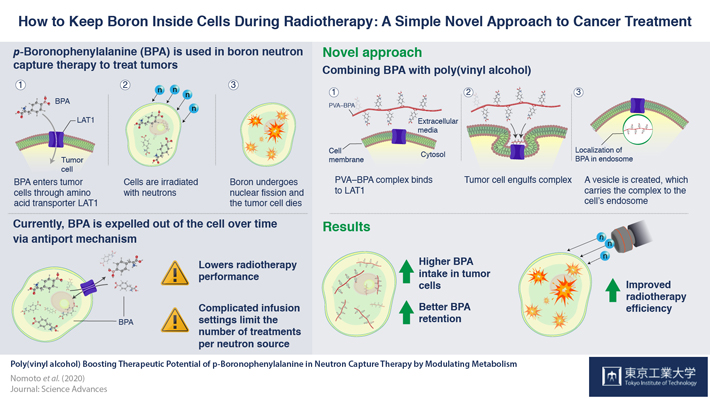Life Science and Technology News
How to keep boron inside cells during radiotherapy: a simple novel approach to cancer treatment
Boron neutron capture therapy (BNCT) is a technique in which p-boronophenylalanine (BPA) is transferred to cancer cells, and the boron in it undergoes nuclear fission reaction upon irradiation of thermal neutrons, releasing high energy particles that kill the cells. However, current technology allows only a short timeframe of BPA in the cell. Scientists at Tokyo Institute of Technology (Tokyo Tech), Kyoto University, and Innovation Center of NanoMedicine (iCONM) improved upon current BNCT by combining BPA with poly(vinyl alcohol) to produce the PVA-BPA complex, which has a longer cell retention time, enhancing the cancer-killing potential of BNCT.

The growing knowledge about cancer biology has enhanced the development of many therapeutic strategies that involve selective targeting and killing of cancer cells. One such therapeutic option is boron neutron capture therapy (BNCT), a radiotherapy process involving transferring boron into cancer cells, and exposing it to neutron particles, causing it to undergo nuclear fission, which kills the cancer cells. If we can ensure that boron is present only in cancer cells, we can specifically destroy only cancer cells, without harming the normal cells of the body.
Scientists first discovered the way to induce this "selective uptake" using p-boronophenylalanine (BPA). BPA is a boron-containing compound with a phenylalanine structure. One of the factors that distinguishes cancer cells from normal cells is an overabundance of special structures called "LAT1 amino acid transporters", which recognize and allow the transport of phenylalanine into the cell. So, when BPA is present outside cancer cells, these transporters on the cell-surface allow it to enter cancer cells, permitting successful BNCT. BPA has long been considered the best drug available for BNCT.
However, BPA has a drawback; once BPA levels increase within the cancer cells, it is expelled back out via an "antiport" mechanism, making it challenging for BNCT to be effective in some cases. Thus, patients are required to receive a continuous infusion of BPA for 30–60 minutes, to maintain the necessary amount in the cells for the reaction to be successful. This also leaves the door open for human errors, such as the possibility of dislodging the needle during the process.
To overcome these drawbacks, scientists at Tokyo Tech, Kyoto University and iCONM led by Prof. Nobuhiro Nishiyama decided to explore other means of retaining boron inside cancer cells for longer periods. "We assumed," Prof. Nishiyama states, "that modulating the presence of BPA inside the cell will ensure that they are not sent back out via their antiport mechanism."
To examine this, they mixed a compound called poly(vinyl alcohol) (PVA) and BPA together, to form a PVA-BPA complex, and observed the internalization of this compound in cancer cells. They found that the addition of PVA did not affect the phenylalanine structure of BPA, allowing the LAT1 transporters to recognize the PVA-BPA complex. However, as this complex was too large to pass through the transporters, the LAT1 transporters instead engulfed the complex in organelles called endosomes and transported them into the cells. Since BPA was now safely located in endosomes, the cancer cell was not able to push it out immediately by the antiport mechanism. This ensured that boron remains in cells for a long enough time for the cancer cells to be effectively killed. This method was also tested in animal models, and anti-cancer activities of BNCT were found to be enhanced.
Addition of PVA thus presents an extremely simple solution to boost the therapeutic potential of BPA. "This technique is effortless," notes Prof. Nishiyama, "and offers a novel approach for drug delivery, focusing on the metabolic elimination processes of drugs. We will advance research on the PVA-BPA complex for clinical trials in cooperation with STELLA PHARMA CORPORATION who has conducted BPA clinical trials."
- Reference
| Authors : | Takahiro Nomoto1*, Yukiya Inoue1, Ying Yao1, Minoru Suzuki2, Kaito Kanamori1, Hiroyasu Takemoto1, Makoto Matsui1, Keishiro Tomoda1, Nobuhiro Nishiyama1,3* |
|---|---|
| Title of original paper : | Poly(vinyl alcohol) Boosting Therapeutic Potential of p-Boronophenylalanine in Neutron Capture Therapy by Modulating Metabolism |
| Journal : | Science Advances |
| DOI : | 10.1126/sciadv.aaz1722 |
| Affiliations : | 1Laboratory for Chemistry and Life Science, Institute of Innovative Research, Tokyo Institute of Technology, Kanagawa 2Division of Particle Radiation Oncology, Particle Radiation Oncology Research Center, Institute for Integrated Radiation and Nuclear Science, Kyoto University, Osaka 3Innovation Center of Nanomedicine (iCONM), Kawasaki Institute of Industrial Promotion, Kanagawa |
- Anticancer drugs delivered by a new drug delivery system reduce tumor size | Life Science and Technology News
- "Nanomachine Contrast Agent" using existing MRI detects minimal cancer tissue with a highly sensitive visualization | Life Science and Technology News
- A nanomachine for "surgery with no incision" developed -- Aiming at outpatient cancer treatment | Tokyo Tech News
- A new nanomachine shows potential for light-selective gene therapy | Tokyo Tech News
- Nobuhiro Nishiyama - Transforming medical care through polymer-based nanomachines | Research Stories | Research
- Six Tokyo Tech faculty members receive FY2019 MEXT Commendation | Tokyo Tech News
- Labs spotlight #50 - Nishiyama Laboratory - | Life Science and Technology News
- NISHIYAMA Laboratory
- Researcher Profile | Tokyo Tech STAR Search - Takahiro Nomoto
- Researcher Profile | Tokyo Tech STAR Search - Nobuhiro Nishiyama
- Laboratory for Chemistry and Life Science, Institute of Innovative Research
- Department of Life Science and Technology, School of Life Science and Technology
- Institute of Innovative Research (IIR)
- Latest Research News
Further Information
Assistant Professor Takahiro Nomoto
Institute of Innovative Research,,
Tokyo Institute of Technology
Email nomoto@res.titech.ac.jp
Tel +81-45-924 -5226
Professor Nobuhiro Nishiyama
Institute of Innovative Research,,
Tokyo Institute of Technology
Email nishiyama.n.ad@m.titech.ac.jp
Tel +81-45-924 -5240





